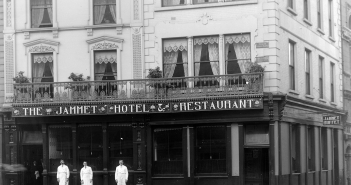Much (reasonable) Ado about Branding and its components
HSBC. The world’s local bank. Clever.
Pepsi brings you back to life. Not a smart one, since in Chinese this translates as “Pepsi brings your ancestors back from the grave[1]”
Mercedes Benz branded itself as ‘Bensi’[2]. Blunder. “rush to die” is what ‘Bensi’ sounds like Chinese.
A brand can be a name, term, sign, symbol or design, or a mix of them all[3], which are used to identify goods or services of one or a group of sellers. Branding helps in differentiation and enables consumers to recall memories, thereby facilitating the initial buying process, or perhaps triggering frequent purchases which brings customer loyalty.
Historically, branding was pursued via effective advertising, both above and below the line. In the East and South Asian markets, however, word-of-mouth remains a key channel of marketing communication, leading to changes in the way branding has come about.
The 3Es of Business Branding are Efficiency, Effectiveness and Experience[4]. It can be argued that although a business needs all three of them to sustain a successful brand, increasingly it’s the ‘experience’ component that differentiates one brand from another. Thus, it is not always about what makes you different, but more importantly, what differentiates you from others.
Enrique Iglesias
It’s increasingly difficult to have an efficiency advantage, or even an effectiveness advantage. Take for example, Enrique Iglesias – performing a selected list of his all-time hits and going live in a large music stadium. The auditorium is packed with two thousand people and even the cheap seats went for about $100 a pop. At the end of the performance the whole auditorium erupts in ecstatic applause.

Later on, Enrique ran a social experiment (as he often does) to test what would happen if he took the same ‘product’ and placed it in a different context. So, he decides to go into a subway station in New York city (which had great acoustics). He dresses up as a busker, posing as a random musician on the street trying to earn a crust.
Iglesias sang the same hits with the same gust one weekday morning. There is security around, nonetheless. You can imagine what happened next. A crowd gathered and everybody was hushed and mesmerized, and it all ended with a big applause at the end.
No, it didn’t go that way.
Only a few people stopped. Few gave him money and a thousand people simply passed by without paying the least bit of attention to a busker playing a few hit songs.
So, what was different in this situation? Well, everything really – maybe it wasn’t the right audience. It was not the right time. They weren’t in the right state of mind or mood. They weren’t expecting it; they didn’t desire to hear this music.
Or they simply couldn’t appreciate it without the branding; without the context; the stage; the auditorium; the advertising, and maybe the ticket prices they paid in the first place also led them to appreciate the pieces more. It was just not the same experience when he played for free.
Substance over Style
Between 1900 and the 1950s, the whole idea about business was efficiency[5]. It was about having access to the supply. It was about controlling the supply. Demand was far in excess of supply at that time.
Among the famous products from that time was the Ford Model T. The famous car available in any colour as long as it was black.

Ford Model T.
The major innovation of that time was the assembly line. And the assembly line was all about efficiency. The objective was to try and get a certain level of output with diminished input to achieve economies of scale. And management of the time was all about the ergonomics of reducing waste in that sense. Their objective was to reduce waste by maintaining the same or reducing input with time, and increase the output – then finally to increase the value at the end of the day.
Efficiency is alive and well today. Recently, Price Waterhouse Cooper interviewed a handful of CEOs, and asked them what were some of the major projects they were launching. 70% said a major cost cutting initiative[6].
Does cost cutting actually work? There’s a recent report in the Harvard Business Review that looked at companies within their sector with below average costs, versus those who had above average costs[7]. It shows that very few of the companies with below average costs had above average profits. those with above average costs had above average profits. i.e., if one did have above average profits, it was typically because one also invested with higher attendant costs.
So, when it comes to cost cutting, it’s okay to cut the bad costs, and not cut the good costs.
Effectiveness
Our next concept is effectiveness, at the industry level, whether a firm is into making automobiles, or maintaining a green supply chain, the focus is largely on value creation. As mentioned earlier, efficiency was all about having a certain level of output with less input – but value chain is quite different.
This approach demands to know: how do you get more out of limited inputs? For example, if you think about it from a people perspective, one aspect of this is about: can I achieve the same end with fewer labour inputs? Basically, would firing people be a good option? Or from a value perspective effectiveness, can you train them?
At a product level, we can look at something like a razor from the perspective of effectiveness. Think of Gillette’s original safety razor? It was a single blade and the idea was that you wouldn’t cut yourself.
The next big innovation was the second blade. The first blade gently lifts the hair out of the follicle. The second one swoops in and cuts it off, giving your face the feel of a baby’s skin.

Gillette Mach 3 razor, circa 2015.
The next innovation was the MACH3, three blades – so, what’s the third blade for? Maybe it exfoliates your skin? Within six months, the competition came in with four blades. Then a few years later, Gillette came out with the Fusion which has five blades. And today, we are aware of MACH14 with 14 blades.[8]
This idea of effectiveness leads to a race in terms of performance. But all of these competitions lead to diminishing returns. The second blade adds a lot over the first blade, the third a little less, and so on. The more and more blades you get the greater the diminishing returns.
When it comes to computers or smartphones companies are competing with diminishing functional benefits. Most people don’t even know what the RAM is on their PCs anymore.
Now do we choose our Mac or iPhone based primarily on its quality? Do we really get a better battery life, higher screen resolution? If we did, we might have chosen an HTC or a Samsung. Therefore, the value chain missed out on a critical component, and that is the consumer of that value chain. Consumers pay over good money for what the companies have created, but they’re not part of the value creation process in any way.
If we consider value within the chain, experience is where the real focus should be. The argument is that no value is created outside of the customer or consumer experience.
Attention to ‘the three Es’
Therefore, a few questions to be asked when working on your brand development. First, how much effort and attention are the top management paying to each of these three Es?
Does the product or service actually have efficiency advantages? If they do, are they actually trading at a lower price compared to the competition? Is that their only differential advantage? Or are they similar to the competitors on the functional and utility benefits? And maybe, whether the firm knows it or not, the experience is actually what is differentiating them from the competition.
A really important question is: if it really is about experience, how are you going to design and deliver experiences? This includes examination of how that experience is different to the design of the product or service itself. There have to be real and radical changes in the way firms design and deliver value to their consumers depending on the market.
For effective cross-cultural branding, go ‘Glocal’ while still staying Global
Word-of-mouth and virtual marketing are also extremely powerful tools in convincing us[9] to transactions frequently with specific businesses over a period of time. Advertising on social media and other channels has also proved effective in establishing brand names.
For example, you may recognise Nike from its symbol or slogan (‘Just Do it’) faster than you would identify Adidas from theirs; Mercedes, BMW and Suzuki are most identifiable through their logos in their sectors, along with Coca Cola or McDonalds in theirs.

Rear light of a Mercedes-Benz C-Klasse.
Companies have continued to leverage these brand assets for decades now. At the same time, they have gone global, and through that internationalization arrived an understanding of the importance of global branding, but also a nuanced awareness of local factors, a phenomenon referred to as glocalization.
Just think of HSBC’s slogan for example: ‘the world’s local bank. Local banks staffed by local peoples,’ which highlights the importance of local knowledge and inclusiveness.
Marketing localization involves taking the source content and adapting it to meet the cultural environment of the target location. [10]. Transcreation on the other hand, is taking the message and recreating it.[11] From language to imagery, the original message and the ‘transcreated’ version can look very different.
Lux Lessons
Let us look at how cross-cultural branding may work in favour or contrary to the interests of companies who adopt it. Lux, a popular name in beauty-healthcare and toiletries, translates as ‘strong man’ in Chinese.[12] This fundamentally contradicts the image of a young lady on its package!

Lux Soap.
Lux entered the Chinese market in the 1980s and a popular Hollywood actress did their TV commercials then. While bathing herself in a large bathtub (certainly an exotic scene to the Chinese viewers at the time), she said seductively “I only use Strong Man. How about you?” Lux became a household name within a few weeks!
However, given that the Chinese use characters based on ideograms and the majority of people are unfamiliar with the Roman alphabet, international brands have to be careful in choosing an appropriate Chinese name.
In Taiwan, Lux means ‘beauty,’ which matches the packaging and how the image of Lux is projected in adverts. Marketing localization focuses on expressing a culturally appropriate message, whereas transcreation creatively transforms the message in order to maximize cultural resonance.
As a language and culture loaded with symbolism and imagery, a direct translation can often lead to comical or negative results. A brand name that has some meaning to the consumer will be more easily recalled. In addition to linguistic cues, other factors that affect the translation/naming process are identified as follows: a) Reflecting product benefits or industry characteristics; b) Quality and brand positioning; c) Links to logo or packaging; d) Country of origin effect, and finally; e) Traditional values, Beliefs and customs.[13]
The social standards of customers differ from culture to culture; one wo/man’s meat is another wo/man’s poison. The ethical values of an organisation determines its corporate image, and ultimately its brand identity.
The company’s culture, heroes, stories and beliefs play a significant role in shaping how its brand and related components are built. An example is how innovation and knowledge inform the different themes or logos owned or used in the Google search engine every day.

Google’s glocal initiatives gives it a secure, trusted and all-encompassing image around the world. Albeit, there are privacy concerns now leading to serious accusation of wrongdoing. In addition to privacy issues, Google has also been a bad boy when it comes to paying taxes and exploiting tax loopholes. Such factors detract from a company’s brand image.
Another example of a ‘glocal’ initiative is with how local level managerial delegation works for Microsoft. Similarly, in order to celebrate its long-term market share and participation, Coca Cola in Turkey briefly renamed itself Koka-Kola[14].
Other examples from the fast-food market include how McDonalds serve dishes and meals that are specific to country contexts and diets. Thus, a meal in the Middle East would have very different ingredients (reflecting local tastes and taboos) from one served in India and China. Similarly, KFC in China serves rice with most orders.
Cultural and cognitive connections are also crucial in international marketing initiatives as companies compete for market dominance. Marketing should establish immediate, cultural bonds with target audiences. Equally important, however, is to guard against over-indulgence in some markets. There may be a danger of patronising a culture when a brand is obviously trying to localise its offering.
Waning Faith in Brands
In 2015, The Economist presented the results of several surveys that warned about waning faith in brands.[15] In North America, consumers said they trusted only about one-fifth of brands. In Europe the proportion barely reached a third.
In a world in which brands ruled for more than a century (e.g. Coca-Colonization, and Tesco-ization, or McDonaldization as presented in research on Globalization), what explains this trend? The ease of accessing information should theoretically make consumer-choice processes easier. Of course, even in the virtual world, full information is not possible.
For brands striving to maintain ‘global-ness’ in their adverts and action, some suggestions would include effective communication of goals, messaging and brand values to stakeholders. This involves explaining, developing and encouraging your vision with employees as much as with customers.
Another important approach is to make use of advanced Translation Management Systems (TMS) that can be used for storing industry-specific and company-specific terminologies such as a tagline or product features. This is mainly to get the tone of your advertisements right!
The next issue is to increase communication with your transcreation team, throughout a project timeline. You should be on hand to to answer questions, discuss disparities, and offer support.
Finally, it is necessary to spend time building trust in your team, by asking generic as well as specific questions, such as will the translation of a German slogan work as well in Canada or another European market? Will your imagery convey the same meaning in China as it does in the US?
A well-established content in one market may not be appropriate for the new market and you have to trust that your transcreation team knows what is the best move. Thus, it is vital to choose a localisation or transcreation team that are aware of cultures and customs.
Featured Image: Enrique Iglesias, Vilnius, Lithuania 2007.11.29 by Kapeksas
[1] Zakkour, Michael (2014). China’s Golden Week – A Good Time To Make Sure You Don’t ‘Bite The Wax Tadpole, Forbes https://www.forbes.com/sites/michaelzakkour/2014/10/02/chinas-national-day-golden-week-a-good-time-to-make-sure-you-dont-bite-the-wax-tadpole/?sh=5ab534f8560f
[2] Etymax (2014). Creating the right name for your brand to prosper in China, https://www.etymax.com/blog/creating-the-right-name-for-your-brand-to-prosper-in-china/
[3] Academy of Management, AOM, https://www.ama.org/the-definition-of-marketing-what-is-marketing/
[4] Wetzlinger, W. et al (2014). Comparing Effectiveness, Efficiency, Ease of Use, Usability and User Experience When Using Tablets and Laptops https://link.springer.com/chapter/10.1007/978-3-319-07668-3_39
[5] Mukhopadhyay, B.R. and Mukhopadhyay, B.K. (2020) Efficiency, effectiveness, experience: Building Business Branding, https://www.sentinelassam.com/editorial/efficiency-effectiveness-experience-building-business-branding-504297
[6] PWC (2015). 18th Annual Global CEO Survey, A marketplace without boundaries? Responding to disruption, https://www.pwc.com/gx/en/ceo-survey/2015/assets/pwc-18th-annual-global-ceo-survey-jan-2015.pdf
[7] Kumar, N. (2006). Strategies to Fight Low-Cost Rivals, Harvard Business Review, https://hbr.org/2006/12/strategies-to-fight-low-cost-rivals
[8] Burns, N. (2006). Shaving With Five Blades When Maybe Two Will Do, New York Times, available at https://www.nytimes.com/2006/01/19/fashion/thursdaystyles/shaving-with-five-blades-when-maybe-two-will-do.html
[9] Whitler, K. (2014). Why Word Of Mouth Marketing Is The Most Important Social Media, Forbes https://www.forbes.com/sites/kimberlywhitler/2014/07/17/why-word-of-mouth-marketing-is-the-most-important-social-media/?sh=6e86aa5054a8
[10] Johnson, J. (2017). Localization vs. Translation: What’s the Difference and Why Does It Matter? Forrester, https://go.forrester.com/blogs/localizationvstranslationwhatsthedifferenceandwhydoesitmatter/
[11] Wolfestone (2016). What is Transcreation and how is it different from translation? https://wolfestone.co.uk/insights/blogs/transcreation-different-translation
[12] Mukhopadhyay, B.R. and Mukhopadhyay, B.K. (2020). Corporate ‘glocalization’ through cross-cultural branding, The Sentinel, https://m.dailyhunt.in/news/india/english/the+sentinel-epaper-senteng/corporate+glocalization+through+cross+cultural+branding-newsid-n185737912
[13] Kimbarovsky, R. (2020). How To Create a Unique and Memorable Brand Identity in 2020, https://www.crowdspring.com/blog/brand-identity/
[14] Mukhopadhyay, B.R. and Mukhopadhyay, B.K. (2020). Corporate ‘glocalisation’ through cross-cultural branding, The Sentinel, https://www.sentinelassam.com/editorial/corporate-glocalization-through-cross-cultural-branding-477722
[15] The Economist (2015). It’s the real thing, https://www.economist.com/business/2015/11/14/its-the-real-thing




